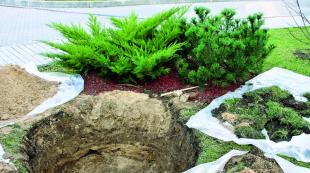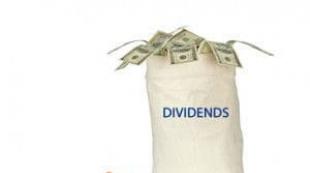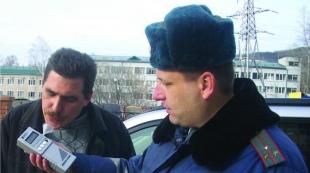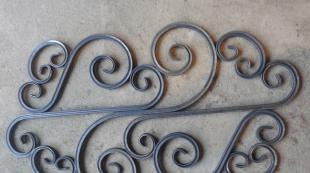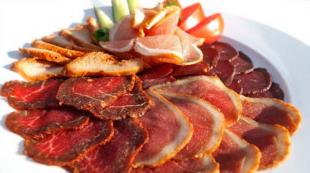Etching of beer aluminum. Alkaline etching Chemical engraving of aluminum
Etching is a process in which part of the metal is removed from the surface by chemical means. This method is used for final processing parts, when preparing a workpiece before applying a coating (electroplating), as well as for creating all kinds of drawings, ornaments and inscriptions.
The essence of the method
Metal etching involves careful surface treatment. A protective coating is applied to the product, which is washed in place of the pattern. Then either acids or an electrolyte bath are used. Unprotected places are destroyed. The longer the exposure time, the deeper the etching of metals occurs. The drawing becomes more expressive and clear. Exist various ways obtaining an engraving (inscription): the image itself or the background can be etched directly. Often these processes are combined. Multi-layer etching is also used.
Etching types
Depending on the substance used to destroy the surface of the material, the following etching methods are distinguished.
1. Chemical method (it is also called liquid). In this case, special solutions based on acids are used. Thus, ornaments and inscriptions are applied to the alloys.
2. Electrochemical etching of metal - involves the use of an electrolyte bath. It is filled with a special solution. Lead salts are also often used to prevent overetching. This method has a number of advantages. Firstly, the drawing is clearer, and the time required to complete the process is significantly reduced. In addition, such metal processing is economical: the volume of acid used is much less than with the first method. Another undoubted advantage is the absence of harmful gases (mordant does not contain caustic acids).
3. There is also an ion-plasma method (so-called dry). In this case, the surface is damaged minimally. This method is used in microelectronics.

Steel Pickling
Basically, this treatment is used to remove scale and various oxides. This procedure requires careful adherence to the technology, since overetching of the base metal is undesirable. The process is used as chemical method and electrolyte baths. Hydrochloric and sulfuric acids are used to prepare solutions. All parts require careful degreasing of the surface. Even a small fingerprint can ruin the workpiece. As a protective coating, varnish based on rosin, turpentine, and tar is used. However, it is worth remembering that the components are flammable substances, so the preparation of varnish requires great concentration and caution. After the metal processing is completed, the etching process itself takes place directly. Upon completion, the part must be cleaned of varnish.

Picklings used for steel
Very often, a solution of nitric acid is used to pickle steel. Also used is salt, tartar (with small additions of nitrogen). Hard steel grades are pickled with a mixture of nitric and acetic acids. Glyphogen is a special liquid based on water, nitric acid and alcohol. The surface is treated with this composition for several minutes. Then washed (solution of ethyl alcohol in purified water), dried quickly. This is a pre-treatment. Only after such manipulations are the workpieces placed in the pickling solution. Cast iron is well pickled in a solution of sulfuric acid.

Pickling of non-ferrous metals
Copper and alloys based on it are pickled with sulfuric, hydrochloric, phosphoric or nitric acids. The process is accelerated by solutions of chromates or nitrates. The first stage is the removal of scale, then the brass is directly etched. Aluminum (and its alloys) are etched in a solution of caustic alkali. For casting alloys, nitric and hydrofluoric acids are used. Spot-welded blanks are treated with phosphoric acid. Titanium alloys are also pickled in two stages. First - in caustic alkali, then in a solution of sulfuric, hydrofluoric, nitric acids. Titanium etching is used to remove the oxide film before electroplating. Molybdenum is treated with a solution based on sodium hydroxide and hydrogen peroxide. In addition, etching of metals (such as nickel, tungsten, for example) is carried out using water, hydrogen peroxide and formic acid.

There are several ways to etch boards. In the first case, water and ferric chloride are used. It can also be made independently. To do this, iron filings are dissolved in hydrochloric acid. The mixture is kept for some time. Also etching printed circuit boards carried out with nitric acid. The whole process takes about 10 minutes. At the end of it, the board must be thoroughly wiped with baking soda, as it perfectly neutralizes the remnants of a caustic substance. Another etching composition includes sulfuric acid, water, hydrogen peroxide (in tablets). It takes much more time to etch the boards with the following composition: hot water, salt, blue vitriol. It is worth noting that the temperature of the solution should be at least 40 degrees. Otherwise, etching will take longer. You can etch boards with direct current. As glassware for this process, you can use glass, plastic container(it does not conduct electricity). Fill the container with edible salt solution. It is he who is the electrolyte. As a cathode, you can take a copper (brass) foil.

Pickling process for other materials
Currently, this type of glass processing, such as etching, is widely used. Vapors of hydrofluoric acid, hydrogen fluoride are used. First, acid polishing of the surface is carried out, then a pattern is applied. After these manipulations, the product is placed in a bath with an etching solution. Then the glass is thoroughly washed and cleaned of the protective coating. As the latter, a mixture based on beeswax, rosin, paraffin. Etching glass with hydrofluoric acid is used to give it a haze. There is also the possibility of color etching. Silver salts give surfaces yellow, red, blue shades, copper salts - green, black, red. To obtain a transparent, shiny pattern, sulfuric acid is added to hydrofluoric acid. If deep etching is required, the process is repeated several times.

Pickling Safety
Metal pickling is a rather unsafe activity that requires a lot of concentration. This is due to work with aggressive materials - acids and their mixtures. First of all, for this process it is necessary to correctly choose a room with good ventilation. Ideal when pickling will use a fume hood. If one is not available, then it is necessary to take care of a respirator to avoid inhalation of harmful fumes. When working with acids, rubber gloves and an apron should be worn. Should always be on hand baking soda, which - if necessary - can neutralize the action of the acid. All pickling solutions must be stored in special containers (glass or plastic). Do not forget about the stickers, which will indicate the composition of the mixture, the date of preparation. There is one more rule: jars of acids should not be placed on high shelves. Their fall from a height is fraught with serious consequences. Artistic metal etching is not complete without the use of nitric acid, which is quite caustic. In addition, in some mixtures it can be explosive. Most often, nitric acid is used for sterling silver. Etching solutions are prepared by mixing acids with water. It is also worth remembering that in all cases the acid is added to the water, and not vice versa.
The most commonly used aluminum etchant is an aqueous solution of sodium hydroxide with or without additives. It is used for general cleaning applications where oxide, grease or sub-surface detritus needs to be removed with longer etch times to achieve a glossy or matte finish. This is used in the production of nameplates or decorative architectural elements, for deep engraving or chemical etching. This etching method is quite cheap, but at the same time it can become too complicated to perform.
Decorative etching solutions may contain 4-10% or more caustic soda, the operating temperature will be 40-90ºC, and it may also be necessary to use a wetting agent to disperse grease and to obtain a light foam coating, as well as to use other additives. The normal operating temperature for cleaning and decorating is 60°C. The figure shows the rate of metal removal at various concentrations and temperatures during a 5-minute pickling of 99.5% aluminum sheet. These curves apply to a freshly prepared solution, with lower values referring to the period after the aluminum has been immersed in the solution. Springe and Shval published data on the pickling rate of 99.5% pure aluminum sheet and extrusion of 6063 in 10%, 15%, 20% sodium hydroxide solutions at 40 to 70°C. Chaterjee and Thomas also did a detailed study of caustic soda pickling extrusion 6063 and sheets 5005, 3013.
Etching rate 99.5% aluminum in caustic soda.
Aluminum dissolves in caustic soda with the release of hydrogen and the formation of a compound aluminate, which exists only in an alkaline solution. The reaction that occurs in this case can be written in two ways:

The amount of free caustic soda decreases as the reaction proceeds, along with this, the etching rate decreases, the electrical conductivity decreases, and the viscosity increases. If no sodium hydroxide is added to the bath at all, the reaction proceeds very slowly, however, eventually the clear or brownish solution becomes milky white, from this point the etching rate starts to increase again, and increases to a value slightly less than initial etching rate. The reaction observed at this stage can be written as follows:
The formed alumina hydrate or Gibsite is in the form of a suspension, while the reaction also releases sodium hydroxide, which is so necessary for the continuation of etching.
Ionic structure of aluminate in solutions having high level pH is a rather complex issue, fortunately the operator is not actually concerned with this problem. Moulenard, Evans and McKeever conducted infrared and Raman spectra for solutions of sodium aluminate in water and deuterium oxide (heavy water), and they also studied the nuclear resonance spectrum for Na and Al. For aluminum concentrations below 1.5 M, they derived 4 vibration zones, two of which were infrared active at 950 and 725 cm-1, as well as 3 Raman zones active at 725, 625 and 325 cm-1. For aluminum, there was also a thin resonance line. All these facts can be quite easily correlated with the existence of tetrahedral Al(OH)4-, which is the main carrier of aluminum in solution.
When the concentration of aluminum exceeds 1.5M, a new vibrational zone appears at 900 cm-1 for the infrared zone and the Raman zone at 705 and 540 cm-1, while the nuclear resonance zone for aluminum will be significantly expanded without changing position. All these observations can be explained in terms of the condensation of Al(OH)4-, with increasing concentration and the formation of Al2O(OH)62-, and in solutions of 6M sodium aluminate, these two forms coexist in parallel. It has been found that sodium hydroxide solution, when used continuously, will absorb aluminum until the volume of free sodium hydroxide is reduced to about one quarter of the original volume, after which etching with free sodium hydroxide will continue, oscillating at approximately the same level with amplitude , which depends on temperature, intensity of use and pause period. The hydrate will then slowly settle or crystallize on the bottom and sides of the tank to form a very hard hydrate which is very difficult to remove and unfortunately tends to settle on the surface of the heating coils. Here we observe the third reaction, i.e. the reaction of dehydrogenation of aluminum hydroxide with the formation of aluminum oxide:
The nature of this transformation is shown in fig. 4-10, where various amounts of aluminum are dissolved in 5% (wt) sodium hydroxide solution, and measurements are made on free sodium hydroxide immediately after each addition, and also after three weeks. Up to 15 g/l of aluminum remains completely in solution without changes in the amount of free sodium hydroxide, however, as soon as the precipitation of aluminum oxide begins, which occurs shortly before the appearance of a freely distinguishable precipitate, free sodium hydroxide is restored to 4%, i.e. up to 80% of its initial value. With prolonged use, this value for such a solution can range from 1 to 1.5%, sometimes increasing to 2.5%, in the event of a downtime lasting several hours. A similar ratio also corresponds to a higher concentration of caustic soda, and these values are actually independent of temperature.

Effect of dissolved aluminum on free sodium hydroxide.
Another important influence of aluminum is that with an increase in the aluminum content, the etching rate decreases, and quite clearly, this is reflected in the figure. In practice, this means that if it is necessary to maintain a constant etching rate, it is necessary to increase the content of free sodium hydroxide as the amount of aluminum in the bath increases.
The final reaction in this case will occur between aluminum and water with the release of hydrogen and aluminum. In theory, pickling can thus continue indefinitely, with the loss of caustic soda occurring only as a result of entrainment. This method of working with the pickling tank is indeed applicable in practice, however, one must remember the need to periodically remove the solid hydrate precipitate. According to current experience, when operating in this mode, the service life of the tank can be up to 2 years. Filtration of sodium hydroxide solutions has not been as successful due to the fact that very fine sediment tends to clog the filter very quickly, but otherwise no problems have been identified with this technique.

Etching rate in sodium hydroxide 50 g/l, sodium nitrate 40 g/l at 60ºС depending on aluminum concentration.
Chemical control of the solution, applied before precipitation or in a stable state after precipitation, includes the determination of total sodium and free sodium hydroxide. The content of the latter can be calculated with sufficient accuracy for practical application by titration with hydrochloric acid until the phenolphtoleic indicator loses its color. As an alternative, potentiometric titration can also be offered. To make up for losses due to entrainment, it is sufficient only to maintain the total content of sodium hydroxide at a fixed level, since it is not possible to control fluctuations in free sodium hydroxide in solution. For an accurate determination, in which carbonate and dissolved aluminum are also taken into account, a more complex calculation method is used, which is given in the table.
One of the most commonly encountered problems with caustic soda etching is the tendency to cause pitting or "burning" of part or all of the part, which is accompanied by an increase in the etch rate of up to 300%. This usually occurs in highly loaded solutions that are used so extensively that there is no way to recover. In this case, the hydrate crystallizes on the parts, which leads to an increase in the intensity of local etching, an increase in temperature and an effect on the grain boundaries, which has the properties of acid etching. It is sometimes difficult to avoid pitting in solutions of this type when trying to remove the anode film. If this happens, the temperature must be lowered.
Thus, it can be seen that, despite the apparent simplicity of the etching process, many competing reactions can be observed in practice, which must be recognized in order to obtain good result. The main factors responsible for pickling are the content of free sodium hydroxide in the solution, the presence and amount of additives in the bath, the temperature of the solution, and the aluminum content of the solution. The influence of the composition of the solution has already been discussed previously, however, the temperature of the solution has a strong influence on the etch rate. Usually this factor is easy to control, but in practice, due to the exothermic nature of this reaction, it is often necessary to cool the pickling baths, especially when they are in continuous use. Most pickling baths are used at temperatures between 55 and 65°C, since at more high temperatures Contamination due to transfer etching may occur, especially on sheet materials.
Greetings, chemists and radio amateurs!
Since the beginning of the year, our Endurance team (LaserLab) has been asked a question, can we make a beautiful engraving on aluminum with a laser? And will it be available to everyone?
Finally we answer! :)
Aluminum is a common metal, so it's no wonder people want to get their engravings on it. I gladly did it for the aluminum key fob, flash drive and the case of my mobile.
What are the properties of aluminum? Yes, metal. T_melting 600 degrees, with high thermal conductivity and often has aluminum oxide on its coating, whose melting point is more than 1100 degrees. Therefore, heat treatment will not be so simple. Let's look at another option. As you know, wires are made of copper and aluminum. Aluminum is an excellent conductor, which means we can use the electrolysis process. This is the trick, read on! Namely, aluminum etching.
It's simple!) We will need:
- Water (no more than 1 liter).
- Source electric current(from 9 to 12 V).
- Common table salt NaCl.
- Dielectric capacitance (for example, made of plastic).
- A nail or other sharp, hard object.
And of course the L-Cheapo laser! Power 3-5 watts.
1. Prepare the design you want to engrave on the aluminum plate.
For example, a bitmap image of a logo.
2. Get rid of grease on your aluminum specimen. Cover it with any of the following materials: brown tape, paint, varnish, tape.


3. Place the product on the 3D printer and run the laser (you need to destroy the surface layer from step 2 and you will get open areas).

4. Stir the salt in the water to make a concentrated solution.

5.1. Take a current source (in the photo there is a red "plus" and a white wire "minus").
5.2. Attach an iron object to the minus and lower it into the saline solution.
5.3. Attach a sample of aluminum to the plus and lower it into the solution in the same container.
6. Power up!

7. Wait for the electrolysis (etching) process in the solution for about 5 minutes. Depending on the concentration of the solution and the strength of the current, estimate the time needed for etching. We were able to etch a sample in a photograph in 3 minutes.

8. Remove the sample from the solution.

Class!!)

Before placing in the container with the solution, do not forget that your sample, which is to be engraved, must be carefully isolated from the external environment, with the exception of those areas where the engraving is to be applied.
You can conduct this experience both at home and in your workshop.
With this technology, anyone can become a metal engraver (at least aluminum).
All this is valuable and practical knowledge. We will be glad if you subscribe to Endurance news
Engrave? Easily!
We are often asked the same question, is it possible to engrave with a diode laser on metal, for example, aluminum.
Is it possible to engrave metal at home?
Today we will answer this question.
Consider aluminum. In fact, it is a fairly common metal in everyday life, suitable for engraving. Many products, such as key fobs, flash drives, and some cell phones have an aluminum coating.
What do we know about aluminum?
This is a metal with a melting point of about 600 degrees Celsius, which has a high thermal conductivity and, as a rule, has a film of aluminum oxide on its surface, whose melting point is more than 1000 degrees Celsius. This greatly complicates the process of engraving by heat treatment, but there is another option. Aluminum is a good conductor, and if so, the electrolysis process has not been canceled. This is the very solution that we will talk about.
This process is called aluminum etching.
There is nothing difficult in this. We only need a 9-12 volt current source.
As well as ordinary table salt NaCl, a dielectric container (plastic is fine), a nail or any iron object of a suitable shape and size, water.
And, of course, the laser!
So what are we doing?
We are preparing a raster drawing that we would like to apply to the aluminum surface of the plate.
For example, like this:
1. 2. We cover the aluminum surface of the plate with a protective film (adhesive tape, varnish, paint of your choice).3. We place an aluminum plate on the desktop of a 3D printer equipped with a diode laser (preferably with a power of over 1-2W, so that it is enough to cut the film), and turn on the laser cutting mode (to burn through the pasted film and create open areas in the place of future engraving ).4. Next, in a plastic container, we prepare a concentrated aqueous solution of NaCl.5. We derive 2 wires “plus” and “minus” from the source of electric current.
6. We attach an iron object (nail) to the minus and lower it into an aqueous solution of NaCl.
7. We attach our aluminum plate to the plus and also lower it into the salt solution.
8. We supply power to the current source.9. The process of electrolysis (etching) in solution begins. Depending on the strength of the current and the concentration of the solution, you can estimate the approximate time required for etching. Usually 3-5 minutes.10. We take the product out of the solution. It must be remembered that the engraved product should be carefully isolated before being placed in the solution, with the exception of those areas where, in fact, it should be applied
This process can be carried out both at home and in a small workshop. With this technology, anyone can become a metal (aluminum) engraver.
In our opinion, this technology is of great practical value.
Subscribe to Endurance updates.
Aluminum engraving made easy!
Aluminum pickling is carried out in an alkaline or acidic environment. A commonly used etchant is concentrated H 3 PO 4 (76%), glacial acetic acid (15%), concentrated nitric acid (3%) and water (5%) by volume. According to research, the process consists of two stages - the formation of Al 3+ and the formation of AlPO 4 , controlled by the rates of the corresponding reactions:
Al 2 O 3 slow Al -3e HNO3 Al 3+ fast fast Film slowly soluble AlPO 4 . (40)
Water in phosphoric acid prevents the dissolution of Al 2 O 3 , but it promotes the dissolution of the secondary product AlPO 4 . The current strength is proportional to the etching rate. If the current is applied to aluminum, then etching anisotropy is observed.
The activation energy of Al etching in H 3 PO 4 /HNO 3 is 13.2 kcal/mol, which suggests that the process is limited by the rate of dissolution of Al 2 O 3 in H 3 PO 4 . The gas released is a mixture of H 2 , NO and NO 2 . Adsorption of gases on the Al surface is a constant problem when using viscous etchants. Bubbles are able to slow down etching - islands of unetched metal are formed under them, which can close closely spaced conductors.
Rice. 17.
The preferential adsorption of gaseous products on the side wall limits side etching.
An unexpected application of bubble adsorption was its use for smoothing the edges of the profile during etching of iron-nickel films in HNO 3 (Fig. 17). As soon as the etching process begins, nitric oxide bubbles collect along the side edge. The adsorbed intermediate NO 2 acts as a strong oxidizing agent in metal etching, and etching in the lateral direction is accelerated. The adsorption of gases on the side wall (Fig. 17) was also used to reduce the side etching of Al during its etching in H 3 PO 4 . A decrease in pressure in the etching chamber from 105 to 103 Pa led to a decrease in etching from 0.8 to 0.4 μm. As a result of the adsorption of small hydrogen bubbles on the side wall, an effective diffusion barrier was formed on it. Several etchants (Table 9) containing additions of sucrose (polyalcohol) and surfactant were proposed to reduce the lateral Al etching from 1.0 to 0.25 µm.
Table 9. Etchant for aluminum.
1) AK - cyclorubber with azides, KTFR type resists; DCN - novolac with quinonediazides, AZ-1350 type resists.
Poor quality Al etching is due to several factors:
- 1) underdeveloped resist;
- 2) uneven thickness;
- 3) stresses in films over steps;
- 4) galvanic acceleration of etching due to the presence of Al-Cu precipitates;
- 5) uneven thickness of the oxide;
- 6) temperature instability (>1 ° C).
These factors lead to overetching and shorting.
Chromium is the second most commonly etched metal after aluminum. It is widely used in the manufacture of photomasks. Cerium sulfate/HNO 3 is used as an etchant.
Due to the inductive effect (the formation of the upper Cr 2 O 3 layer), the etching of the film is non-linear, and therefore the end of etching cannot be determined from its initial thickness.
